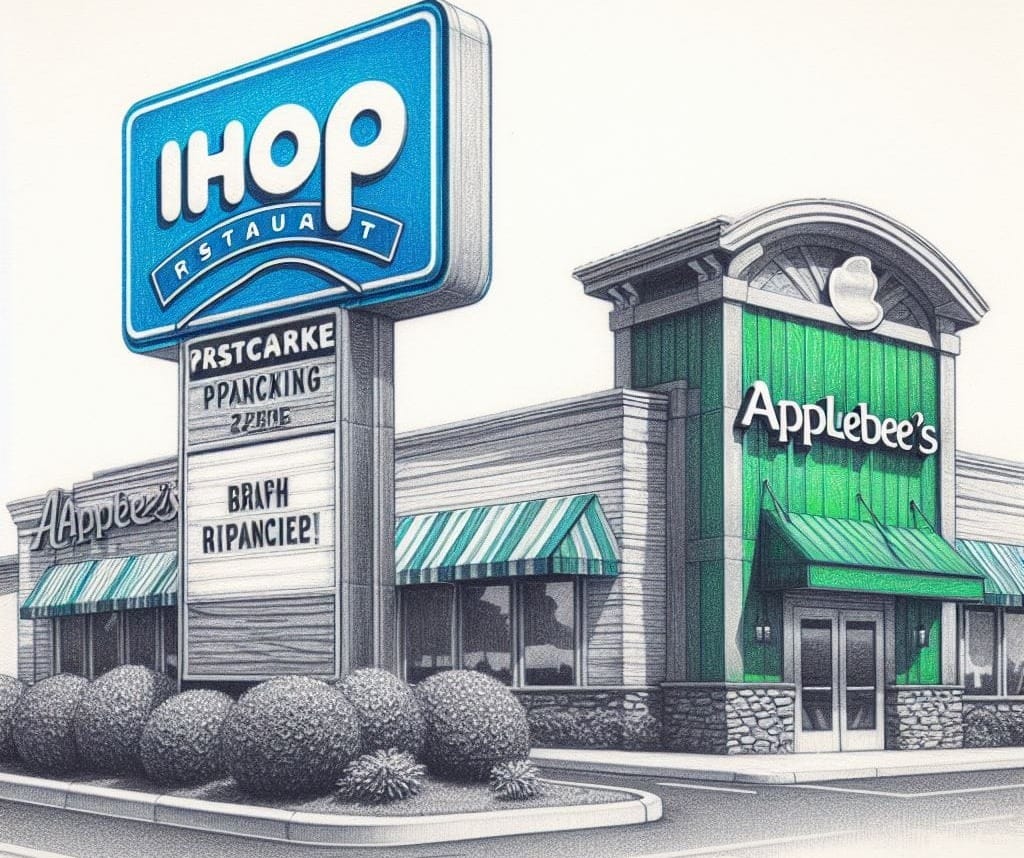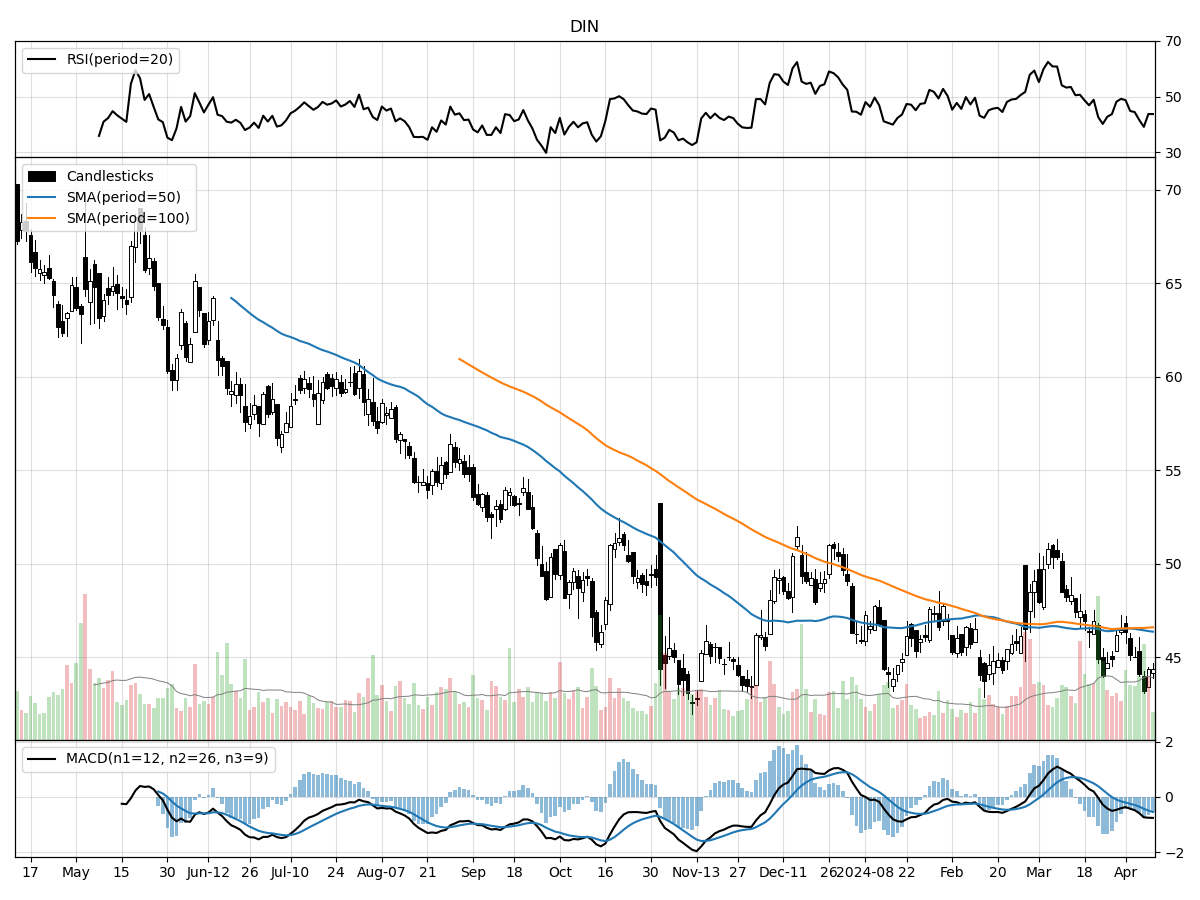Dine Brands Global, Inc. (DIN), Mid/Small Cap AI Study of the Week

April 11, 2024
Weekly AI Pick from the S&P 400 or S&P 600
Company Overview
Dine Brands Global, Inc. operates primarily in the United States, franchising the Applebee's, IHOP, and Fuzzy's Taco Shop restaurant concepts. As of the end of 2023, the company had 3,588 restaurants, with international operations accounting for a small portion of its revenue. The majority of Dine Brands' revenue comes from franchise operations, and the company focuses on growth through innovation, technology, marketing, and potentially acquiring new brands.
IHOP has seen growth in its 24/7 operations and is expanding its 'IHOP 'N' Go' business along with launching a loyalty program. The company entered the fast-casual Mexican dining segment with the acquisition of Fuzzy's Taco Shop, which complements its existing portfolio. Franchise agreements with Dine Brands involve fees, royalties, and contributions to national advertising funds. The company offers incentives for new restaurant development and requires franchisees to allocate funds for marketing.
Dine Brands plans to open numerous IHOP, Applebee's, and Fuzzy's Taco Shop locations domestically and internationally over the next several years. They maintain quality and compliance through regular inspections and financial reviews of franchises. The franchise ownership is diverse for Applebee's and IHOP, but more consolidated for Fuzzy's. The company occasionally operates company-owned restaurants, focusing on strategic refranchising.
The supply chain is managed through an independent cooperative to ensure cost savings and quality, while the company faces intense competition in the restaurant industry. Dine Brands holds and renews trademarks for its brands, invests in technology for operational efficiency, and complies with data security standards. Sales show modest seasonality with a slight increase in the first quarter. The company is regulated by various laws and has refranchised Applebee's locations while acquiring and refranchising Fuzzy's Taco Shops. It also navigates evolving privacy laws and food industry regulations.
By the Numbers
Annual 10-K Report Summary:
- Net income: $97.2 million (up from $81.1 million the previous year)
- Earnings per diluted share: $6.22 (up from $4.96 the previous year)
- Applebee's system-wide sales: Decrease of 0.1%
- Applebee's domestic same-restaurant sales: Increase of 0.6%
- IHOP system-wide sales: Increase of 6.0%
- IHOP domestic same-restaurant sales: Increase of 3.5%
- Total reported retail sales: $7,920.2 million (up from $7,724.7 million)
- Applebee's restaurant count: Decrease of 2.1% (closing 36 locations)
- IHOP restaurant count: Increase of 1.9% (opening 33 locations)
- Fuzzy's franchise revenue: $13.6 million
- Total revenue: $831.1 million (down by $78.3 million)
- Total gross profit: Increase by $19.4 million
- Franchise expenses: Increase by $22.5 million
- Rental operations profit: $32.5 million
- Financing operations revenue: Decline (specific value not provided)
- General & Administrative expenses: Increase by 3.8%
- Closure and impairment charges: $3.6 million
- Interest expense: $70 million (significant increase)
- Loss on disposition of assets: Reported (specific value not provided)
- Debt refinancing: Paid off $585.1 million in Class A-2-I Notes
- Amortization of intangible assets: Increase (specific value not provided)
- Income tax provision: $14.5 million
- Effective tax rate: 13.0%
- Total cash, restricted cash, and equivalents: Decrease to $100.6 million (from $425.3 million in 2021)
- Long-term debt obligations: $1.194 billion
- Interest obligations: $290.9 million
Quarterly 10-Q Report Summary:
- Net income decline (3-month period): $2.5 million
- Net income decline (9-month period): $5.6 million
- Applebee's domestic same-restaurant sales (quarter): Decrease of 2.4%
- Applebee's domestic same-restaurant sales (9 months): Increase of 0.9%
- IHOP domestic same-restaurant sales (quarter): Increase of 2.0%
- IHOP domestic same-restaurant sales (9 months): Increase of 4.2%
- Applebee's franchise restaurants: Net reduction of 9 (total 1,652)
- IHOP franchise restaurants: Net addition of 4 (total 1,794)
- Revenue decrease (quarter): 13.1%
- Revenue decrease (9 months): 10.9%
- Reported revenues (quarter): $202.5 million
- Reported revenues (9 months): $624.7 million
- Franchise operations gross profit: Increase (specific value not provided)
- IHOP franchise fee revenue: Increase (specific value not provided)
- Applebee's franchise fee revenue (quarter): Decrease
- Applebee's franchise fee revenue (9 months): Slight increase
- Rental operations gross profit: Slight increase (specific value not provided)
- General and administrative expenses increase (quarter): 4.9%
- General and administrative expenses increase (9 months): 11.8%
- Net interest expense: Increase (specific value not provided)
- Income tax provision: Decrease (specific value not provided)
- Net cash from operating activities (9 months): $79.3 million (up from $63.5 million)
- Long-term debt repayment: $218.0 million
- Common stock repurchase: $20.0 million
- Dividend payout: $31.7 million
- Debt service coverage ratio (DSCR): 3.7x
- Available borrowing capacity: $221.6 million
- Net cash position decrease: $165.3 million
- Net cash position after borrowing: $59.6 million
Stock Performance and Technical Analysis

Based on the provided technical data for the stock, there are several indicators that can help inform an investment decision. The stock's current price is $44.36, which is 4% above its 52-week low and 36% below its 52-week high. This suggests that while the stock has recovered somewhat from its lowest point in the past year, it is still significantly below its peak. Investors might view this as a potential discount if they believe the stock's intrinsic value is closer to its 52-week high, assuming the fundamentals of the company have not deteriorated.
The trading volume is also an important indicator to consider. The recent daily volume is higher than the longer-term average (324,196.5 shares/day vs. 244,998.13 shares/day), which could indicate increased investor interest or volatility in the stock. However, without additional context on whether the volume is associated with buying or selling, it's difficult to interpret this as a bullish or bearish sign on its own.
The stock's recent performance shows an 8.04% decline over the last month but relative stability over the last three months. This could suggest that, despite short-term bearish momentum, the stock is finding some level of support at its current price range. The Money Flow indicators pointing to moderate selling pressure and distribution support the notion that there may be bearish sentiment in the market for this stock. Additionally, a bearish MACD (Moving Average Convergence Divergence) value of -0.54 further indicates that the stock is currently in a downward momentum phase, as the MACD is a trend-following momentum indicator that shows the relationship between two moving averages of a stock's price.
Overall, the technical analysis paints a picture of a stock that is currently facing selling pressure, with a bearish trend indicated by the negative MACD value. The drop in price over the last month and the position of the price between its 52-week high and low suggest that investors may need to be cautious. It would be prudent to consider the broader market conditions, any recent news or earnings reports from the company, and to compare the stock's performance to its peers before making an investment decision. If the fundamental analysis suggests that the company's financial health and growth prospects are strong, the current price could represent a buying opportunity; however, if the fundamentals are weak, it may be wise to hold off until the technical indicators show signs of a stronger reversal in momentum.

The ‘Bull’ Perspective
Summary:
- Steady Growth Amidst Industry Challenges: Despite the broader industry challenges, Dine Brands has demonstrated resilience, with IHOP's same-restaurant sales growing by 2.0% in the latest quarter and 4.2% over nine months.
- Strategic Refranchising and Expansion: The company’s strategic refranchising has led to a more capital-light model, and the acquisition of Fuzzy's Taco Shop signals growth potential.
- Solid Financial Management: Dine Brands maintains a strong debt service coverage ratio (DSCR) of 3.7x and has actively managed its capital through debt repayment, stock repurchases, and consistent dividends.
- Adaptation to Market Trends: The company has navigated the pandemic's impact with a pivot to off-premise sales and digital initiatives, positioning it well for evolving consumer habits.
- Attractive Valuation and Dividend Yield: With a decrease in net income reflected in the stock price, Dine Brands currently offers an attractive valuation and a dividend yield that may appeal to income-focused investors.
Elaboration:
- Steady Growth Amidst Industry Challenges:
The restaurant industry has faced significant headwinds, including inflationary pressures and changing consumer preferences. However, Dine Brands has shown commendable resilience, particularly through IHOP's performance. IHOP's same-restaurant sales have increased by 2.0% for the quarter and 4.2% over nine months. This growth, in the face of a 2.4% decline in Applebee's same-restaurant sales for the quarter, underscores the strength and adaptability of the IHOP brand. The company's overall revenue decrease is primarily due to strategic refranchising, which should not overshadow IHOP's robust performance. With consumer spending remaining sturdy in the face of a tight labor market, as evidenced by the 303,000 nonfarm payrolls added in March, the potential for sustained traffic and revenue growth at IHOP is promising. - Strategic Refranchising and Expansion:
Dine Brands has made strategic moves to shift towards a more capital-light model by refranchising Applebee's company-operated restaurants. This transition has resulted in a temporary decrease in revenue but positions the company for improved profitability and reduced operational risk. Moreover, the acquisition of Fuzzy's Taco Shop reflects a strategic expansion into a fast-growing segment, diversifying the company's portfolio and creating new avenues for growth. With 1,794 IHOP restaurants and 1,652 Applebee's locations, the brand's footprint remains significant, and the addition of Fuzzy's Taco Shop is an exciting venture that could drive future revenue streams. - Solid Financial Management:
Dine Brands' financial prudence is evident in its debt management and capital allocation strategies. A DSCR of 3.7x is robust, indicating the company's strong ability to service its debt. The company has been proactive in repaying $218.0 million in long-term debt and repurchasing $20.0 million worth of common stock, showcasing a commitment to shareholder value. Furthermore, the consistent dividend payments totaling $31.7 million underscore a shareholder-friendly policy. These actions, coupled with a net increase in cash from operating activities to $79.3 million for the nine months ended September 30, 2023, reflect a solid financial foundation that should reassure investors. - Adaptation to Market Trends:
Dine Brands has adeptly navigated the challenges posed by the pandemic, pivoting towards off-premise sales and enhancing digital capabilities. While off-premise sales for IHOP have slightly decreased year-over-year, the company has laid the groundwork for a flexible business model capable of adapting to consumer trends. As the economy continues to recover and the labor market remains robust, Dine Brands is well-positioned to capitalize on the resurgence of in-person dining while retaining the gains made in delivery and takeout services. - Attractive Valuation and Dividend Yield:
The decline in net income, as reported in the latest quarterly report, may have led to a more attractive valuation for Dine Brands' stock. For investors, this could present a buying opportunity, especially considering the company's commitment to dividends. The current stock price may not fully reflect the underlying strength of the IHOP brand or the potential upside from strategic initiatives like the Fuzzy's Taco Shop acquisition. Income-focused investors, in particular, may find the dividend yield appealing, offering a potential stream of income along with the prospect of capital appreciation as the company continues to execute on its growth strategy.
In conclusion, Dine Brands Global, Inc. presents a compelling investment case. The company has demonstrated resilience in a challenging industry, made strategic moves to position itself for future growth, and maintained a strong financial position. As the market digests the latest economic data and the Fed's rate decisions, Dine Brands' stock offers a combination of growth potential and income generation that could be a recipe for success in investors' portfolios.

The ‘Bear’ Perspective
Upfront Summary:
- Declining Net Income: Dine Brands Global's net income has decreased by $2.5 million and $5.6 million for the three-month and nine-month periods ending September 30, 2023, respectively.
- Underperformance in Key Segments: Applebee's domestic same-restaurant sales dropped by 2.4% for the quarter, and both Applebee's and IHOP underperformed their market segment benchmarks.
- Increased Expenses: The company has seen a rise in general and administrative expenses by 4.9% and 11.8% for the three and nine-month periods, respectively, largely due to higher personnel costs and expenses related to acquisitions.
- Rising Debt Concerns: With approximately $1.2 billion in debt and restrictive covenants, Dine Brands Global faces increased risk of default and limited financial flexibility.
- Market and Regulatory Risks: External factors such as economic downturns, legal proceedings, and compliance with new regulations could further strain the company's financials.
Elaboration on Points:
- Declining Net Income:
Dine Brands Global's financial health has shown signs of strain with a substantial decline in net income, a key indicator of profitability. The $2.5 million and $5.6 million reductions in net income for the respective three-month and nine-month periods ending September 30, 2023, are troubling signs for investors. This decline is attributed to increased costs that have not been offset by corresponding revenue growth. Such a downward trend in profitability, if it continues, could significantly impact the company's ability to invest in growth and maintain its competitive edge in the market. - Underperformance in Key Segments:
Performance metrics specific to the restaurant industry, such as same-restaurant sales, are critical for assessing a company's health. Applebee's has experienced a worrisome decline of 2.4% in domestic same-restaurant sales for the quarter, while IHOP's growth has not been sufficient to allay concerns. The underperformance against market segment benchmarks indicates that Dine Brands Global is losing ground to competitors, which could lead to a loss of market share and further revenue declines. - Increased Expenses:
The rise in general and administrative expenses, particularly the 11.8% increase over the nine-month period, is a red flag for cost management within Dine Brands Global. The acquisition-related expenses and higher personnel costs contribute to a growing expense base that could erode profit margins. In an industry where cost control is paramount to success, such increases in overhead could spell trouble for the company's long-term financial stability. - Rising Debt Concerns:
The substantial debt load of approximately $1.2 billion is a significant concern, especially given the restrictive covenants attached to this debt. These covenants could limit the company's operational flexibility and, if breached, could result in severe consequences, including loss of control over assets. Moreover, the risk of default becomes increasingly real in an economic downturn, which could lead to a liquidity crisis and potential bankruptcy. - Market and Regulatory Risks:
Dine Brands Global must navigate a complex landscape of market and regulatory risks. Economic headwinds, such as inflation and reduced consumer spending, could further dampen sales. Legal proceedings and the costs of compliance with evolving regulations, such as food safety and employment laws, add to the company's burden. The potential for significant impairment charges, as witnessed in 2020, looms over the company, threatening to increase the stockholders' deficit and depress the stock price further.
Conclusion:
In light of the aforementioned points, a cautious stance on Dine Brands Global, Inc. is recommended. The combination of declining net income, underperformance in key segments, rising expenses, substantial debt concerns, and various market and regulatory risks presents a challenging outlook for the company. Investors should be wary of these red flags, as they suggest a potential for continued financial underperformance and increased volatility in the company's stock price.




Comments ()